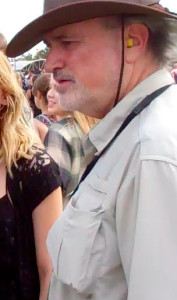 RICHARD LUTZ directs you to this week’s movie on the flatscreen you just shouldn’t miss.
RICHARD LUTZ directs you to this week’s movie on the flatscreen you just shouldn’t miss.
We are so used to bang-bang, kiss-kiss that we sometimes fail to let a film envelop you in slow long shots, sounds of the wind, quiet in a wilderness.
The movies are just too fast, edited so sharp and hard that you can’t draw a breathe between gulps of caramel popcorn.
If this is how you feel, slap on the hard drive for The New World (Fri; 01.10 AM Film4) for a slow cooking epic about how colonial settlers did or didn’t deal with its problems of European culture colliding full tilt with local folks in the American woods.
The extended cut is close to 3 hours (chopped back to just over 2 hours for thee and me) and director Terrence Malick allows the camera to amble, caress and hold firm on the shots so you can take in the simple beauty of a virgin colonial America, so lush sometimes that you can lose your breathe as you watch the corn whisper in the wind, the candle gutter in the cabin, the fire flicker in the unfathomable dark of a continent not really seen before by Jacobean eyes.
Of course, Malick’s intention is to make you question who is the savage in the New World? Is it the Algonquin tribes in their tents and huts in the woods or the settlers with their impulse to implant upon the Indians their own ideas of property, theft and retribution.
It is a theme worthy of Shakespeare’s The Tempest (after all the events took place in 1607) and tests you to make a decision about who you back: the tribes trying to accept these strange new ex-pats with their guns, their forts and their western skills. Or the native Americans with their lack of personal property, their ability to live in the wild and their sudden rages when pushed to the wall.
Malick is famous for his use of the camera to pick up the slow turn of nature. And also for not banging out movies. In four decades, he had only made six feature films, once famously taking a 20 year break between productions.
For The New World (1995) he shot a million feet of film, banned all artificial lighting and made his actors lose 20 pounds in weight to reflect the ravages of living outside the borders of western life. He had a vision – and his enemies. Co-star Christopher Plummer vowed never again to work with this maestro because of his idiosyncratic methods.
But it may have been worth the pain. Malick fills the screen with the America that the settlers were confronted with and within this frame re-tells the story of how Capt John Smith (Colin Farrell) fell in love with chieftain’s daughter Pocahantos for a real life Romeo and Juliet tale about forbidden love between clans as two worlds clashed and the settlers faced starvation, disease and their own inadequacies as they tried to carve a new life.
There is commendable back-up from Christain Bale, David Thewlis and the aforementioned Plummer. Malick has since gone on make two more films since The New World- both highly contested by viewers and critics.
Channel 4 cheated just a bit by recently transmitting something called New Worlds about rebellious settlers coming to America after the Restoration. It didn’t cut the mustard despite all the big hair, olde worlde frocks and shouty men with big swords and clumpy leather boots.
That made-for- tv series was embarrassing to watch. The real deal about 17th century Britain’s impact on America is from Malick. And it’s a masterpiece.
*Screengrab takes a break and returns soon.



